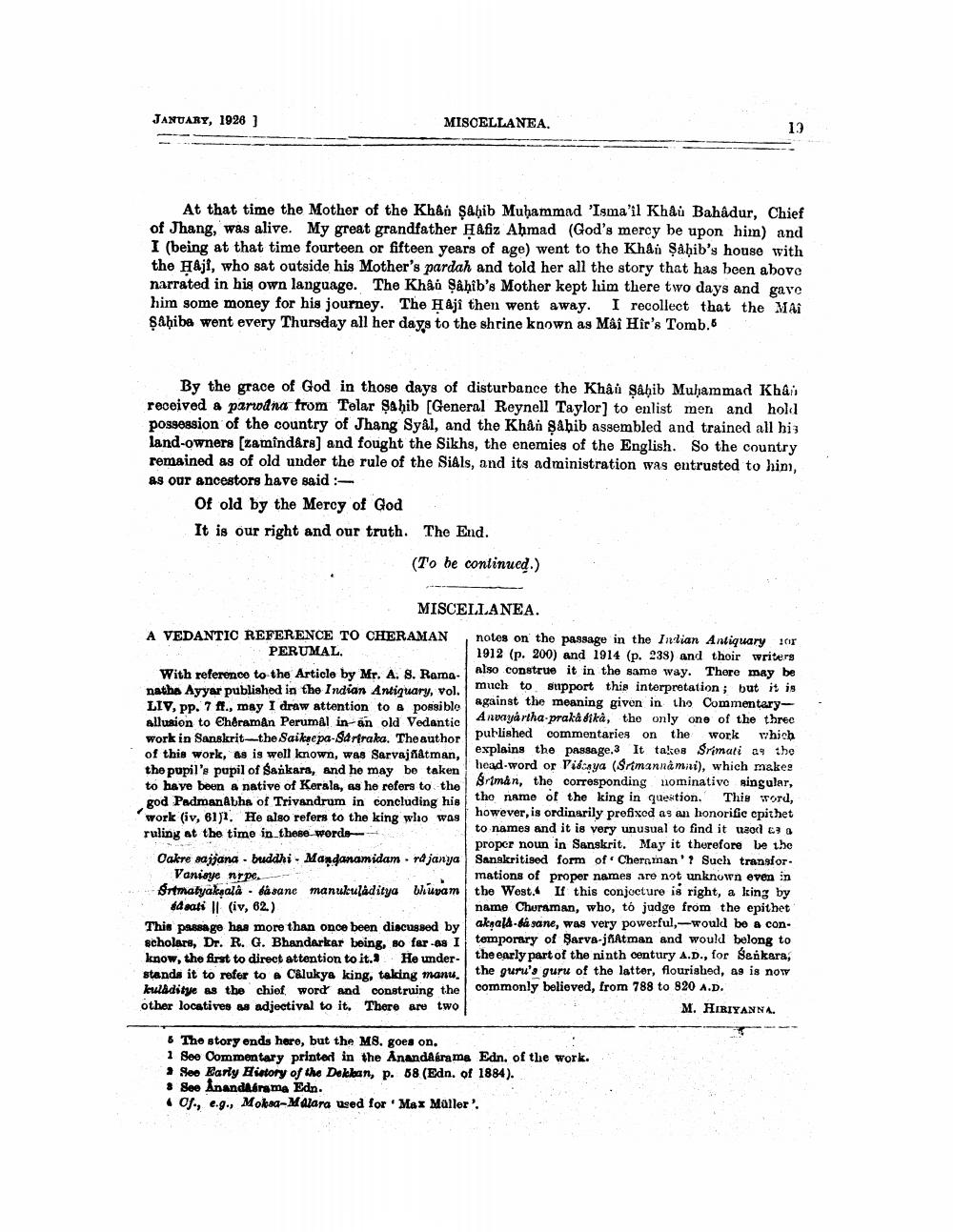________________
JANUARY, 1926 ]
MISCELLANEA.
13
At that time the Mother of the Khân Şahib Muhammad 'Isma'il Khai Bahadur, Chief of Jhang, was alive. My great grandfather Hafiz Ahmad (God's mercy be upon him) and I (being at that time fourteen or fifteen years of age) went to the Khân Şahib's house with the Haji, who sat outside his Mother's pardah and told her all the story that has been above narrated in his own language. The Khao Sahib's Mother kept him there two days and gave him some money for his journey. The Haji then went away. I recollect that the Mai şahiba went every Thursday all her days to the shrine known as Mai Hir's Tomb.
By the grace of God in those days of disturbance the Khâu şahib Muhammad Khai received a parrodna from Telar Şahib [General Reynell Taylor) to enlist men and hold possession of the country of Jhang Syål, and the Khân şahib assembled and trained all his land-owners (zamindårs) and fought the Sikhs, the enemies of the English. So the country remained as of old under the rule of the Sials, and its administration was entrusted to him, as our ancestors have said :
of old by the Mercy of God It is our right and our truth. The End.
(To be continued.)
MISCELLANEA. A VEDANTIC REFERENCE TO CHERAMAN notes on the passage in the Indian Antiquarydor PERUMAL.
1912 (p. 200) and 1914 (p. 239) and thoir writers With reference to the Article by Mr. A. S. Rama
also construe it in the same way. There may be natha Ayyar published in the Indian Antiquary, vol.
much to support this interpretation, but it is LIV, pp. 7 ff., may I draw attention to a possible
against the meaning given in tho Commentaryallusion to Chéramån Perumal in- an old Vedantic
Anwyártha-prakådika, the only one of the three work in Sanskrit--the Saiksepa-Saniraka. The author
published commentaries on the work which of this work, as is well known, was Sarvajnåtman,
explains the passage.3 It takes Srimati 29 the the pupil'e pupil of Sankara, and he may be taken
head word or Vidaya (Srimanna mni), which makes to have been a native of Kerala, es he refers to the
Sriman, the corresponding nominative singular, god Padmanabha of Trivandrum in concluding his
tho name of the king in question. This word, work (iv, 61). He also refers to the king who was
however, is ordinarily prefixed as an honorific cpithet ruling at the time in these worde
to names and it is very unusual to find it uodega
proper noun in Sanskrit. May it therefore be the Oakre sajjana - buddhi. Mandanamidam. nd janya Sanskritised form of Cherninan'? Such translor. Vanisye nope.
mations of proper names are not unknown even in Sntmatyaknala - fasane manueuladitya bhuvam the West. If this conjocture is right, a king by &d sati || (iv, 62.)
name Churaman, who, to judge from the epithet This passage has more than once been discussed by
aknald-fá sane, was very powerful, -would be a con. scholars, Dr. R. G. Bhandarkar being, so far as I temporary of Şarva-jfatman and would belong to know, the first to direct attention to it. He under the early part of the ninth century A.D., for Serkara. stands it to refer to a Câlukya king, taking manu.
the guru's guru of the latter, flourished, 49 is now Kuldstye as the chief word and construing the commonly believed, from 788 to 820 A.D. other locatives as adjectival to it. There are two
M. HIRIYANNA.
6 The story ends here, but the M8. goes on. 1 See Commentary printer in the AnandAgrama Edn. of the work. > See Early History of the Deklan, p. 88 (Edn. of 1884). 3 See Anandabrama Edn.
Of., e.g., Moha-Malara used for. Max Müller'.




